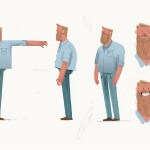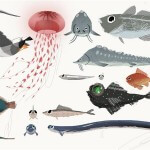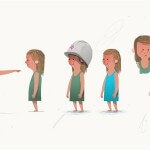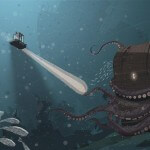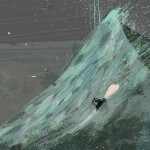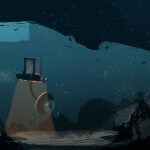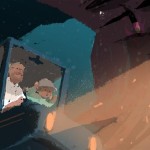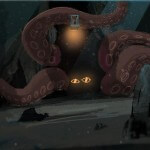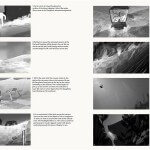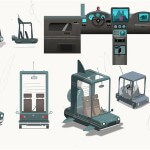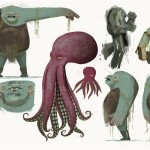Studio AKA, Statoil and David Prosser
Last year was a great year for student animation. Especially over at the Royal College of Arts where the works of Mikey Please, Matthias Hoegg and David Prosser all got nominated for BAFTAs, with Mikey Please taking home the award for “The Eagleman Stag”.
However, when all the essays have been forgotten about and the mortarboard and gown have been returned to the hire company the real work begins for those fortunate and talented enough to find employment. We caught up with David Prosser, nearly one year on from his BAFTA nod to see how he managed to overcome the challenges on his first job directing a commercial for a Norwegian oil company working at one of the UKs most innovative and stylish animation houses, Studio AKA.
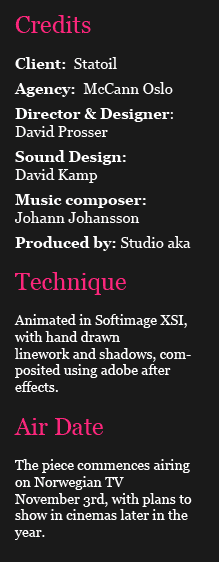 Congratulations on the advert, can you explain to the readers a little about the project and what the concept is?
Congratulations on the advert, can you explain to the readers a little about the project and what the concept is?
Yes, currently the piece exists only in Norwegian as that’s the market in which it airs first, but there will be an English subtitled version to follow. The spot opens with a father finishing reading a bedtime story to his little girl as she becomes inquisitive as to what he ‘actually’ does at work. From here we are projected into the girl’s vivid imagination inspired by her dad’s explanation of his work far out at sea and how his job is challenging and filled with obstacles. In her imagination we see the girl and dad aboard a magical car in which they navigate the assault course of obstacles, from water trolls to octopus. Eventually they arrive at the treasure at which point dad’s voice over explains, “It’s almost impossible to reach”. We are finally transported safely back into the girl’s bedroom where we see she’s nodding off.
The concept from the start was book ended with live-action to ground the story in the real world, so it was our task to try and integrate a seamless transition from this reality into the animated imagination sequence. I decided to use the family car as a vessel for this transition, something that would be a familiar safe environment
and associated with long journeys. The car/submarine also helps us keep track of the two flying through these vast vistas.
Studio AKA have a vast array of talented artists and designers on their books, were you chosen for the project or do you have to pitch?
Actually this is a popular misconception, which I assume is brought about by the visual array of styles presented by the studio, the AKA rosta is actually surprisingly small with each director being very creatively versatile. In this circumstance the project brief required all the directors in-house to pitch. My pitch was selected by the agency (McCann Oslo), and I was given the chance to develop it further to present on to the client. From there we went through various rounds of designs until we were commissioned to develop a moving test. This was mainly to help the client visualise some of the relatively ‘expressive’ concept drawings and how they would translate to 3D, as I knew I wanted to retain 2D linework too. To have the extra weeks developing the aesthetics of the pitch was pretty luxurious , it seems more and more often this is being asked for when pitching, but we were very lucky to be in the position of this stage being funded as I realise this is a rare occurrence these days. Brilliantly, the test succeeded in selling the concept in to the client
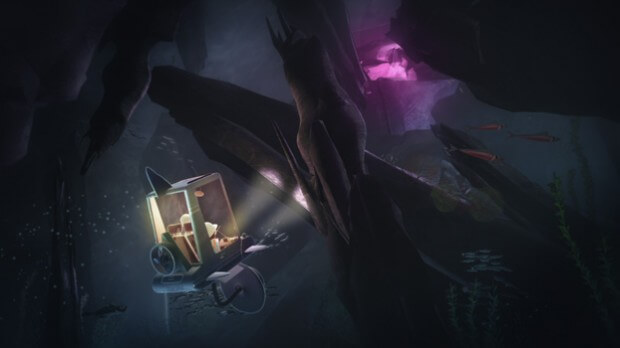
The RCA prepare their students to a high level , with this being your first professional project with the studio, were you prepared for the jump from student film to professional commission?
There is no substitute for actual industry experience and this is something that the RCA couldn’t possibly prepare me for. Although they did help me secure an internship at STUDIO AKA. The cold sweats of the student film, working all night with nothing but microwaved coffee and trusty sweat pants is a magical experience but probably one best confined to every few years. At work you arrive and try to contain the work within the working day. I like it, it makes you more pragmatic. The whole experience working with such a large team at AKA was ace, I was always blown away with what the guys in 3D can produce, the whole thing was a massive learning curve for me. Although throughout, Marc Craste, the senior director at Studio AKA was always on hand as a consultant to the project, and having senior producer Nikki Kefford at the helm made the whole experience less daunting.
How much creative space did the advertising agency give you? How much responsibility did you have for the style or content?
McCann we’re great with this, they trusted the scope we had with the world and the characters and were pretty much hands off throughout, what you see style wise has barley been doctored. The client were also very trusting in our capabilities and has a huge respect for the studio, which made the production process pleasurable all round. The original script that was pitched was far too long, so this was condensed and we were free to interpret within reason. Clearly it had to be set out at sea and there was various characters that they were desperate to include, notably the troll, which I was able to steer out of the direction of the typical Norwegian design.
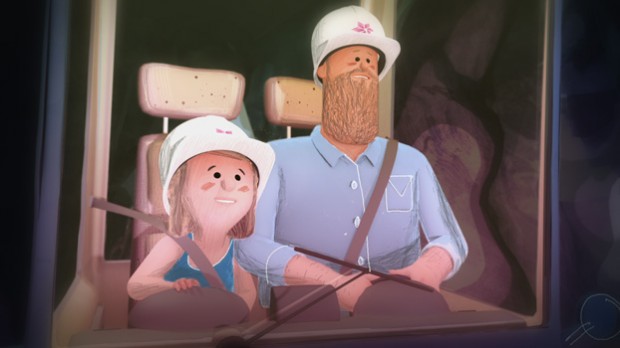
What was the inspiration behind the style and content of the advert?
I was keen to include cross over in the transition from live-action to animation so there are objects from the girl’s room which are reflected in the animation and vice a versa (if you look closely you can see the troll and the octopus!). The world had to be playful enough to reflect the young girl’s imagination and not too dark, yet be reflective of the apparent dangers of the ocean and the obstacles that have to be overcome in this intrepid line of work. They’re is also layers of 2D animated objects and loose 2D linework throughout the animated world, an element that hopefully harks back the that of a childlike drawing, slight naive imperfections that give a depth to the spot and also an element of my signature.
Before joining the RCA you had never really animated before with your training and from a director’s point of view, do you think as an artist or animator?
That’s a good question, I think in the commercial world more than any you have to wear many hats and often some at the same time. I don’t think you could survive just being one in the commercial domain.
How did the communication between a Norwegian and British companies effect the project? What were the challenges?
They were great, very thorough throughout and relatively hands off. There weren’t many challenges with the agency/studio relationship per se but communicating ideas and constraints to the live-action director was a little more problematic. As we would be tracking animation into the live-action some things were occasionally overlooked in the frenzy of the one day shoot.
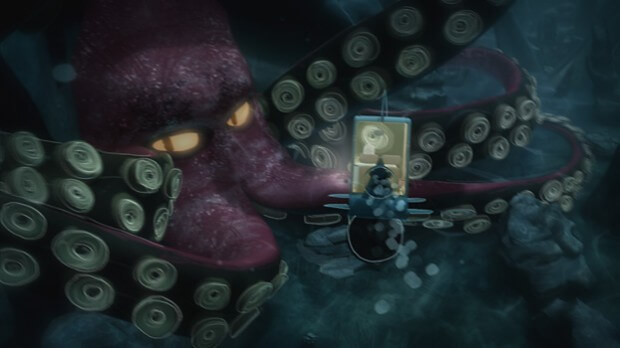
In your last interview with us you said “I never really wanted to become an animator; I’d much prefer to be an illustrator”. Has your experience in the last year altered that perception?
Ha. I’d still like to sit and spend more time on static images, it’s not that I don’t want to be an animator its just that I never imagined I would be.
How would you advise an animator or company aspiring to find work in the world today? With this being an Anglo-Norwegian collaboration would you say the opportunity to find work anywhere in the world is still plentiful?
It seems there’s still plenty of work out there, and on many pitches we seem to be competing globally. In my experience to date the American agencies tend to expect a more concise and developed pitch, with a greater variety of possibilities. I think the key to finding work is to be visible in the commercial arena, which for me has been enabled by Studio aka. There’s no golden rule to pitching except to be true to yourself creatively, and create something that you feel confident you are able to execute to high standard within the parameters of the sometimes restrictive commercial boundaries.

Do you have time to work on any personal projects? Marc Craste worked on ‘Jo Jo and the Stars’ whilst doing commercial work, have you been lucky enough to find the time?
It’s been tricky as I’ve only been at Studio AKA just over a year and so have been busy learning the ropes. I have recently had the opportunity to work on some internal projects that will hopefully manifest themselves sometime in the future. Aside from that I’ve been working with Mike Please developing some early concept work for his epic sci-fi feature.
What’s next for Studio AKA and Dave Prosser?
I’m looking forward to working on many more exciting projects as part of my experience with Studio AKA


